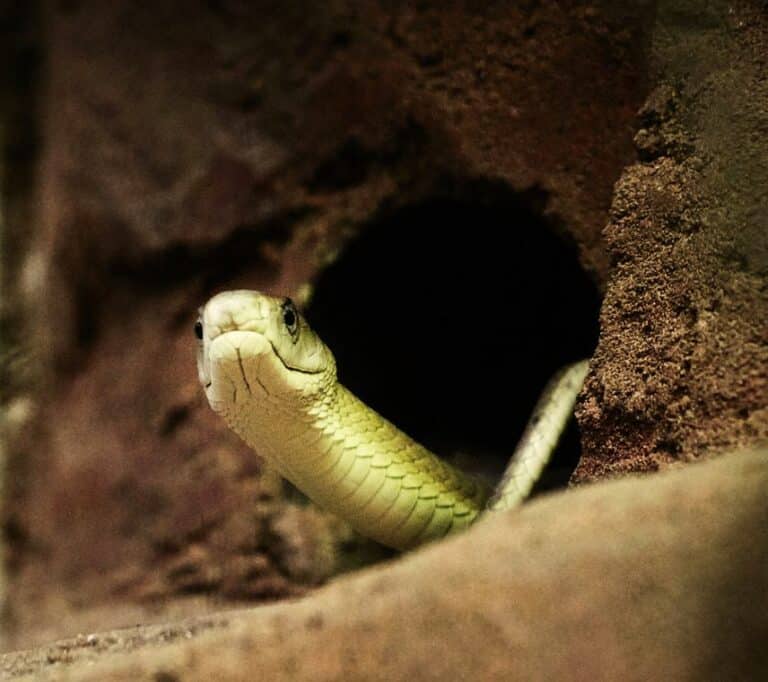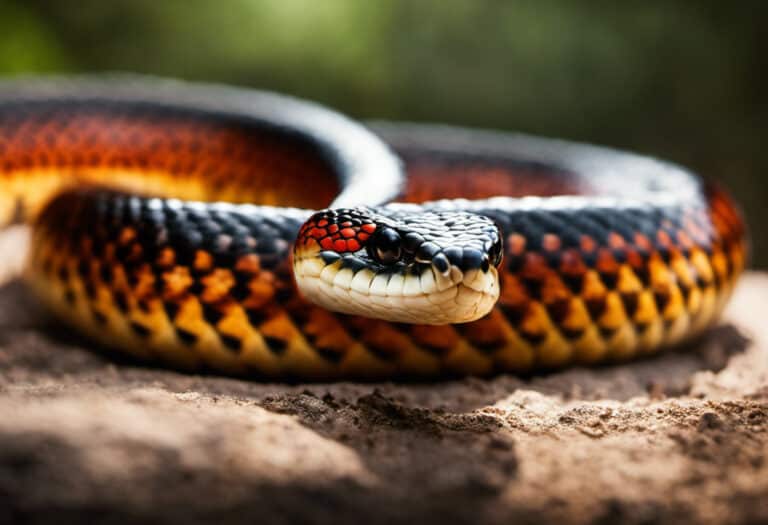Do Eastern Ribbon Snakes Bite?
Have you ever wondered if Eastern Ribbon Snakes bite? Well, wonder no more! In this article, we’ll explore their behavior, defense mechanisms, diet, reproduction, distribution, and risk assessment.
These slender snakes, with three thin light-colored stripes, are non-aggressive and rarely bite unless provoked. We’ll also compare them to the Common Gartersnake.
So, if you’re curious about their biting habits, keep reading! You’ll find all the fascinating details you need to satisfy your curiosity.
Key Takeaways
- Eastern Ribbon Snakes are non-aggressive and rarely bite humans unless provoked.
- They are docile and avoid direct contact with people and pets.
- They have a defense mechanism of secreting a foul smell from anal glands to deter predators.
- Their non-venomous nature makes them not dangerous to people or pets.
Behavior and Defense Mechanisms
Eastern ribbon snakes are non-aggressive and will only bite humans if provoked. Their behavior and defense mechanisms are fascinating.
When danger approaches, these snakes hide in bushes or take to water to escape. Interestingly, they possess a unique gliding behavior, allowing them to gracefully glide over the surface of water instead of diving. This serves as a clever escape strategy against predators.
Additionally, eastern ribbon snakes can secrete a foul smell from their anal glands to deter predators. This defensive mechanism is effective in keeping potential threats at bay.
These snakes have evolved these behaviors to ensure their survival in their natural habitat. Understanding their gliding behavior and defensive mechanisms helps us appreciate the remarkable adaptations of these beautiful creatures.
Diet and Feeding Habits
You might be interested to know that the diet of ribbon snakes primarily consists of amphibians and insects. These slender creatures have specific feeding habits that help them survive in their natural habitat. Here are four key aspects of the Eastern Ribbon Snake’s diet and feeding habits:
-
Amphibians: The Eastern Ribbon Snake feeds on a variety of amphibians, including small fishes, frogs, toads, tadpoles, and salamanders. These prey items provide a good source of nutrients for the snake’s survival.
-
Insects: Along with amphibians, the Eastern Ribbon Snake also consumes a significant amount of insects. This includes various types of insects such as beetles, grasshoppers, crickets, and spiders.
-
Hunting Behavior: These snakes are active hunters and typically hunt during the mornings and early evenings. They’ve a keen sense of sight and smell, which helps them locate their prey.
-
Feeding Method: Unlike some snakes that bite or tear their prey, the Eastern Ribbon Snake swallows its prey whole. This efficient feeding method allows them to consume their food quickly and efficiently.
Reproduction
If you’re curious about the reproduction of Eastern Ribbon Snakes, it’s worth noting that mating occurs during the fall, while fertilization and reproduction take place in the spring after hibernation.
During mating, male Eastern Ribbon Snakes insert a copulatory plug to prevent mating with other males. After a gestation period of three months, females give birth to a varying number of offspring, ranging from four to 27 young ones at a time.
The offspring are typically born in late summer. Eastern Ribbon Snake offspring development is independent, as they don’t require assistance from their parents and can start hunting soon after birth.
This reproductive behavior allows for the freedom of the young snakes to establish their own feeding patterns and survival strategies in their habitats.
Geographic Distribution
The Eastern Ribbon Snake is commonly found in wetlands, bogs, streams, salt marshes, and lakes throughout the northeastern parts of the United States, excluding the Appalachian Mountains and southeastern parts of Canada.
Factors influencing the geographic distribution of Eastern Ribbon Snakes include habitat suitability, temperature, and prey availability.
In regions with suitable wetland habitats, the population of Eastern Ribbon Snakes is higher compared to regions with less suitable habitats.
The distribution of Eastern Ribbon Snakes varies in different regions, with higher populations observed in coastal areas compared to mountainous regions.
This may be due to the preference of the species for wetland habitats, which are more abundant in coastal areas.
Additionally, the presence of water bodies in these regions provides the snakes with suitable hunting grounds and access to prey.
Risk Assessment
The Eastern Ribbon Snake is docile and poses no danger to you or your pets, rarely biting to defend themselves. This non-venomous snake is known for its calm demeanor and avoids direct contact with humans and animals. When faced with danger, it will hide in bushes or take to the water to escape.
Unlike its close relative, the Common Gartersnake, the Eastern Ribbon Snake has a more slender body with three thin, light-colored stripes running along its back. While they may have similar appearances, the Eastern Ribbon Snake isn’t known to bite unless provoked. Its primary defense mechanism is to secrete a foul smell from its anal glands to deter predators.
Overall, you can rest assured that encountering an Eastern Ribbon Snake in the wild poses minimal risk to you and your pets.
Frequently Asked Questions
What Is the Average Lifespan of an Eastern Ribbon Snake?
The average lifespan of an Eastern Ribbon Snake is around 5 to 7 years. These snakes have specific habitat requirements, preferring wetlands, bogs, streams, salt marshes, and lakes. They are non-aggressive and rarely bite unless provoked.
Can Eastern Ribbon Snakes Swim?
Yes, Eastern Ribbon Snakes can swim. They are comfortable in both water and on land. As for climbing trees, they have a preference for wetland habitats and are not known to climb trees. Regarding hibernation, they do hibernate during winters.
Do Eastern Ribbon Snakes Have Any Predators?
Eastern ribbon snakes, also known as Thamnophis sauritus, are small, non-venomous snakes found in the eastern United States. They have predators like birds of prey, larger snakes, raccoons, and foxes in their habitat.
How Do Eastern Ribbon Snakes Communicate With Each Other?
Eastern Ribbon Snakes communicate through visual signals and vocalizations. They use body movements and posture to convey messages to other snakes. Vocalizations, such as hissing, may also be used in certain situations.
Are Eastern Ribbon Snakes Protected by Any Conservation Efforts?
Eastern Ribbon Snakes are not protected by specific conservation efforts, but they are generally not threatened. The main threats to Eastern Ribbon Snakes include habitat loss, pollution, and predation by larger animals.
Conclusion
In conclusion, Eastern Ribbon Snakes are fascinating creatures that rarely bite unless provoked. Their non-aggressive nature and slender bodies with light-colored stripes make them unique in the snake world.
So, if you ever come across an Eastern Ribbon Snake in the northeastern United States, remember to appreciate their beauty and respect their space. It’s always best to observe these amazing creatures from a safe distance and let them continue their peaceful existence in their natural habitat.






